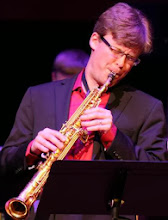Let me start by saying that A Love Supreme is far from my favorite recording, or even my favorite John Coltrane recording. Now, before you get all excited about this, please take a breath and read on.
By the time I had my first listening experience with the original album, I already knew that this music had been placed on a pedestal before I was even born. There was no chance of me being able to have an authentically original opinion, and even if I had an opinion, it was irrelevant.
An Immutable Stone Tablet
So A Love Supreme entered my world as a 2,000 year old stone tablet, an immutable monolith that had critically shaped a certain view of the jazz world for so long that nobody could remember a world without its influence.
I own a copy on cd, and a very nice copy on vinyl, and I never listen to either of them. I can listen to Coltrane's Sound or Live at the Half Note on infinite loop for days at a time, but A Love Supreme for me is like a heavy meal that you eat once every five or ten years, and maybe you enjoy it more because the Michelin star chefs tell you that it is the best meal in the world, but you find yourself half passed out somewhere between trauma and regret.
A Torch to the Heavens
With all that unpacked (whew!), I have that music in my musical DNA as much as any other modern jazz musician - whatever that means, but you can interpolate that as you like. I find it a little cringey when musicians quote from it, but on my first concert after the pandemic lockdown, I found myself extending a solo by a chorus and uncontrollably witnessing A Love Supreme coming out of my horn like a torch to the heavens as the band responds in kind (link below)
When the newly recovered live version was released, I admittedly dragged my feet before purchasing it on vinyl. I bought it more as scholar than fanatic - I mean, I cannot be a saxophone professor and not study this alternate universe that we can see through some dark and dirty mirror through time and space. And then, it sat on my shelf for two months. I couldn't bring myself to even unwrap the cellophane, never mind place it on the turntable. What will it say about me if I hate it? Or if I love it?
On December 26, 2021, I could no longer reasonably procrastinate. The time had finally come.
There are some important considerations that make this live version very unique. Obviously, it is performed live with a few extra musicians moderately contributing (Pharoah Sanders and Donald Garrett). The movements and the soloing are extended, stretching over two generous vinyl discs. The setting is not exactly what you would call "sacred." The Penthouse was a jazz club that capitalized on the Playboy image of the time, with stylized rabbits in the decor and waitresses dressed as one might imagine.
The recording itself is like having a bad seat in the club. The drums are too close, and Trane seems to be far away, maybe on the other side of the piano. You strain to hear him, even though his sound is clearly massive and encompassing. But, this is a time machine and like many of the rare recordings, it is worth a bit of squinting to see through the fog of history to get a glimpse of real magic that was nearly lost forever.
Upon the first listening, I settled into the sound and established a mental focus on the scene. I hear some noodling, people talking, some applause - I am in the room. About 15 minutes into the first movement, tears well up in my eyes for no particular reason. I suppose that the intensity of the music and the auspiciousness of hearing any previously unheard music by this ensemble is always a heavy load to process.
The music itself is familiar, yet strangely different. Pieces of the old stone carvings are spaced out with more extended soloing. At times, it sounds less like the holy sacrament of the studio album and more like . . . well, like the classic quartet blowing in a jazz club. Because that is what it is - the John Coltrane Quartet at work.
Conclusions
The end result for me is quite unexpected. For the first time in my life, A Love Supreme is a living thing, as if the weight of that stone tablet is lifted. I feel a greater connection between this and my own work. When we place art/artists on pedestals, we tend to forget that they are made of the same star dust as everything else that we have ever known. Yes, A Love Supreme is a particularly unique and powerful masterpiece, but it is only music, created by musicians that walked the same streets and gazed upon the same sky as the rest of us.
I look forward to going back to the original recording to see how it will change with this new perspective, but I think that I will give it some time. After all, no matter how you experience it, this music is a heavy dose of jazz expressionism that requires attention and space.


No comments:
Post a Comment